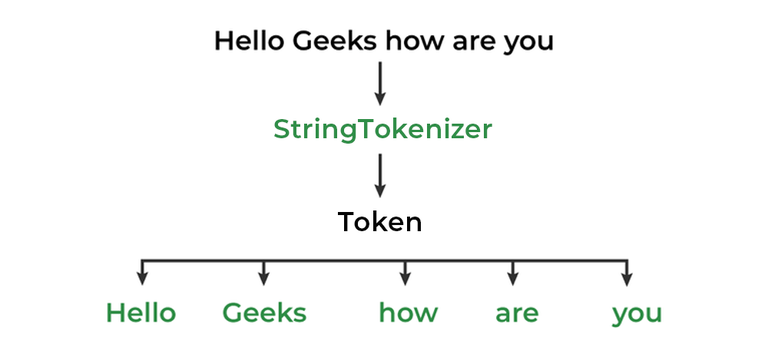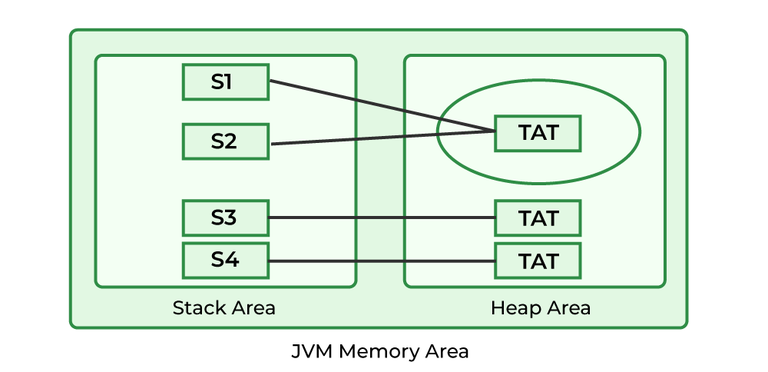Java Strings (original) (raw)
In Java, a **String is the type of object that can **store a sequence of characters enclosed by double quotes, and every character is stored in 16 bits, i.e., using **UTF 16-bit encoding. A string acts the same as an array of characters. Java provides a robust and flexible API for handling strings, allowing for various operations such as concatenation, comparison, and **manipulation.
**Example:
String name = "Geeks";
String num = "1234"
**Program:
Java `
// Java Program to demonstrate String public class Geeks {
// Main Function
public static void main(String args[])
{
// creating Java string using a new keyword
String str = new String("Geeks");
System.out.println(str);
}}
`

String Example in Java
**Ways of Creating a Java String
There are two ways to create a string in Java:
- String Literal
- Using new Keyword
**Syntax:
<String_Type> <string_variable> = "<sequence_of_string>";
**1. String literal (Static Memory)
To make Java more memory efficient (because no new objects are created if it exists already in the string constant pool).
**Example:
String demoString = “GeeksforGeeks”;
**2. Using new keyword (Heap Memory)
- String s = new String("Welcome");
- In such a case, JVM will create a new string object in normal (non-pool) heap memory and the literal "Welcome" will be placed in the string constant pool. The variable s will refer to the object in the heap (non-pool)
In the given example only one object will be created. Firstly JVM will not find any string object with the value "Welcome" in the string constant pool, so it will create a new object. After that it will find the string with the value "Welcome" in the pool, it will not create a new object but will return the reference to the same instance.
**Example:
String demoString = new String (“GeeksforGeeks”);
**Interfaces and Classes in Strings in Java
- **CharBuffer: This class implements the CharSequence interface. This class is used to allow character buffers to be used in place of CharSequences. An example of such usage is the regular-expression package java.util.regex.
- String: It is a sequence of characters. In Java, objects of String are immutable which means a constant and cannot be changed once created.
CharSequence Interface
CharSequence Interface is used for representing the sequence of Characters in Java. Classes that are implemented using the CharSequence interface are mentioned below and these provides much of functionality like substring, lastoccurence, first occurence, concatenate , toupper, tolower etc.
- String
- StringBuffer
- StringBuilder
**1. String
String is an immutable class which means a constant and cannot be changed once created and if wish to change , we need to create an new object and even the functionality it provides like toupper, tolower, etc all these return a new object , its not modify the original object. It is automatically thread safe.
**Syntax:
// Method 1
String str= "geeks";// Method 2
String str= new String("geeks")
2. StringBuffer
StringBuffer is a peer class of **String, it is mutable in nature and it is thread safe class , we can use it when we have multi threaded environment and shared object of string buffer i.e, used by mutiple thread. As it is thread safe so there is extra overhead, so it is mainly used for multithreaded program.
**Syntax:
StringBuffer demoString = new StringBuffer("GeeksforGeeks");
3. StringBuilder
StringBuilder in Java represents an alternative to String and StringBuffer Class, as it creates a mutable sequence of characters and it is not thread safe. It is used only within the thread , so there is no extra overhead , so it is mainly used for single threaded program.
**Syntax:
StringBuilder demoString = new StringBuilder(); demoString.append("GFG");
4. StringTokenizer
StringTokenizer class in Java is used to break a string into tokens.
**Example:

A StringTokenizer object internally maintains a current position within the string to be tokenized. Some operations advance this current position past the characters processed. A token is returned by taking a substring of the string that was used to create the StringTokenizer object.
**StringJoiner is a class in _java.util package which is used to construct a sequence of characters(strings) separated by a delimiter and optionally starting with a supplied prefix and ending with a supplied suffix. Though this can also be done with the help of the StringBuilder class to append a delimiter after each string, StringJoiner provides an easy way to do that without much code to write.
**Syntax:
public StringJoiner(CharSequence delimiter)
Above we saw we can create a string by String Literal.
String demoString ="Welcome";
Here the JVM checks the String Constant Pool. If the string does not exist, then a new string instance is created and placed in a pool. If the string exists, then it will not create a new object. Rather, it will return the reference to the same instance. The cache that stores these string instances is known as the String Constant pool or String Pool. In earlier versions of Java up to JDK 6 String pool was located inside PermGen(Permanent Generation) space. But in JDK 7 it is moved to the main heap area.
Immutable String in Java
In Java, string objects are immutable. Immutable simply means unmodifiable or unchangeable. Once a string object is created its data or state can't be changed but a new string object is created.
**Example:
Java `
// Java Program to demonstrate Immutable String in Java import java.io.*;
class Geeks { public static void main(String[] args) { String s = "Sachin";
// concat() method appends
// the string at the end
s.concat(" Tendulkar");
// This will print Sachin
// because strings are
// immutable objects
System.out.println(s);
}}
`
Here, Sachin is not changed but a new object is created with “Sachin Tendulkar”. That is why a string is known as immutable.
As we can see in the given figure that two objects are created but s reference variable still refers to "Sachin" and not to "Sachin Tendulkar". But if we explicitly assign it to the reference variable, it will refer to the "Sachin Tendulkar" object.
**Example: Java program to assign the reference explicitly in String using String.concat() method.
Java `
// Java Program to demonstrate Explicitly assigned strings import java.io.*;
class Geeks { public static void main(String[] args) { String name = "Sachin"; name = name.concat(" Tendulkar"); System.out.println(name); } }
`
**Memory Allotment of Java String
String literal
Whenever a String Object is created as a literal, the object will be created in the String constant pool. This allows JVM to optimize the initialization of String literal. The string constant pool is present in the heap.
**Example 1: Using String literals to assigning char sequence value.
String str1 = "Hello";

**Example 2: When we initialize the same char sequence using string literals.
String str1 = "Hello";
String str2 = "Hello";

Using new Keyword
The string can also be declared using a **new operator i.e. dynamically allocated. In case of String are dynamically allocated they are assigned a new memory location in the heap . This string will not be added to the String constant pool.
**Example 1: Using new keyword to assign a char sequence to a String object.
String str1 = new String("John"); String str2 = new String("Deo");

If we want to store this string in the constant pool then we will need to “intern” it.
**Example 2: Using .intern() to add a string object in string constant pool.
// this will add the string to string constant pool.
String internedString = demoString.intern();
It is preferred to use String literals as it allows JVM to optimize memory allocation.
If we notice if we use new keyword or string literals both store the values in the string but the difference is if we use the string literals or intern() the string object it will store the values in the string constant pool which is present inside the heap as shown in the image.
**Example that shows how to declare a String:
Java `
// Java Program to Declare a String import java.io.; import java.lang.;
class Geeks { public static void main(String[] args) {
// Declare String without using new operator
String name = "GeeksforGeeks";
// Prints the String.
System.out.println("String name = " + name);
// Declare String using new operator
String newString = new String("GeeksforGeeks");
// Prints the String.
System.out.println("String newString = " + newString);
}}
`
Output
String name = GeeksforGeeks String newString = GeeksforGeeks
**Note: String Object is created in Heap area and Literals are stored in special memory area known as string constant pool.
String Pool Migration from PermGen to the Normal Heap
PermGen space is limited, the default size is just 64 MB. it was a problem with creating and storing too many string objects in PermGen space. That's why the String pool was moved to a larger heap area. To make Java more memory efficient, the concept of string literal is used. By the use of the 'new' keyword, The JVM will create a new string object in the normal heap area even if the same string object is present in the string pool.
**For example:
String demoString = new String("Bhubaneswar");
Let us have a look at the concept with a Java program and visualize the actual JVM memory structure:
**Below is the implementation of the above approach:
Java `
// Java program and visualize the // actual JVM memory structure // mentioned in image class Geeks { public static void main(String args[]) {
// Declaring Strings using String literals
String s1 = "TAT";
String s2 = "TAT";
// Declaring Strings using new keyword
String s3 = new String("TAT");
String s4 = new String("TAT");
// Printing all the Strings
System.out.println(s1);
System.out.println(s2);
System.out.println(s3);
System.out.println(s4);
}}
`

String Pool in Java
**Note: All objects in Java are stored in a heap. The reference variable is to the object stored in the stack area or they can be contained in other objects which puts them in the heap area also.
**Example 1:
Java `
// Construct String from subset of char array
// Driver Class class Geeks { public static void main(String args[]) {
// Creating Byte ASCII Array
byte ascii[] = { 71, 70, 71 };
// Creating String using byte array
String firstString = new String(ascii);
System.out.println(firstString);
// Creating String using byte array with
// Start index to End Index
String secondString = new String(ascii, 1, 2);
System.out.println(secondString);
}}
`
**Example 2:
Java `
// Construct one string from another class Geeks { public static void main(String args[]) {
// Character Array
char characters[] = { 'G', 'f', 'g' };
// Creating new String using Character Array
String firstString = new String(characters);
// Creating new String using another String
String secondString = new String(firstString);
System.out.println(firstString);
System.out.println(secondString);
}}
`